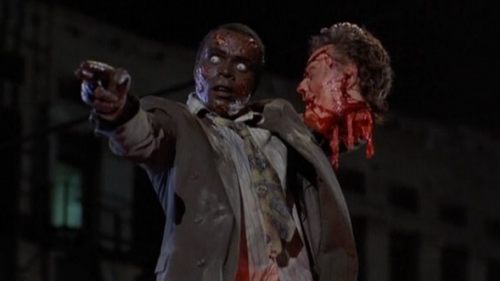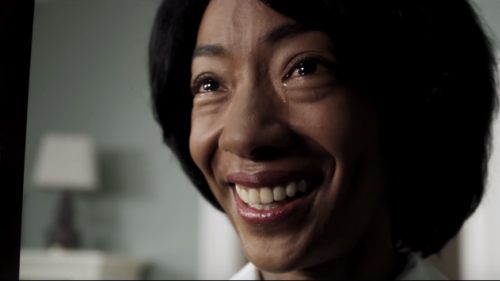To Live And Die In LA: TALES FROM THE HOOD (1995)
Get Out hits theaters this week (buy your tickets here), and we are celebrating with a week of articles inspired by the film.
The OJ Simpson verdict was announced on October 3, 1995. After hearing nine months’ worth of statements, arguments and evidence, the jury took four hours to deliberate and find the defendant, Orenthal James Simpson, not guilty on two counts of murder in the deaths of his ex-wife, Nicole Brown Simpson, and Ronald Goldman, a waiter from a nearby restaurant. The United States had been sitting on edge since the night of the murders in June 1994, watched with bated breath as the football-cum-movie star fled from police in a white Ford Bronco, and were glued to the television throughout the entirety of the trial. The tragedy of OJ Simpson became a mirror for the country to stare into; allowing each and every one of its citizens to examine the intertwined ethical consequences of race, fame and violence that plagued their nation.
When the words “not guilty” were uttered by the jury forewoman, shockwaves flowed through the country. Black people were elated, viewing the acquittal as a communal victory over a system that had worked to oppress them en masse. Just three years earlier, they’d witnessed Rodney King get brutalized at the hands of several LAPD officers. Despite the notorious videotape that surfaced, catching the savage beating in full, the four offending officers were judicially let off the hook for the assault. As a direct result, the city of Los Angeles exploded, as its denizens perpetrated one of the worst riots in American history. Angry citizens took to the streets, expressing their rage via violence and property destruction. For many black people, OJ Simpson’s acquittal was due justice and payback of sorts for this atrocity going unpunished. Meanwhile, many white people felt violated, citing the massive stack of evidence the prosecution compiled as being ignored in the name of The Juice’s fame. It was a pivotal moment for race relations in the United States that has just begun to be explored in the form of superlative televised drama (The People vs. OJ Simpson) and one of the greatest documentaries ever crafted (OJ: Made in America).
Horror movies are often said to be a reflection of our societal woes. Don Siegel’s Invasion of the Body Snatchers (’56) is frequently labeled a comment on McCarthyism. George Romero’s Night of the Living Dead (’68) transmuted Jim Crow era photographs of racist Southern cruelty into the zombie picture, going as far as to have gangs of rural whites shoot its black protagonist at the film’s conclusion. Wes Craven’s Last House on the Left (‘72) and Tobe Hooper’s The Texas Chain Saw Massacre (’74) commented on the death of a country’s innocence due to the conflict in Vietnam. During the greed fueled '80s, body counts grew in franchises spawned from Halloween (’78), Friday the 13th (’80), and A Nightmare on Elm Street (’84); maniacs hacking their way toward big profits for studios. So it only makes sense that the racial repercussions Los Angeles radiated through the rest of the country would find their way to the big screen, courtesy of Executive Producer Spike Lee (whose Do the Right Thing [‘89] still stands as the greatest filmic statement on race in America). Originally conceived as a stage play titled Black Horror Show, writer/director Rusty Cundieff (Fear of a Black Hat [‘93]) took the EC Comics anthology format and rejiggered it into a socially conscious wrecking ball. Re-naming it Tales From the Hood and releasing it in May 1995 (smack dab in the middle of the Simpson trial), the end result is still one of the most important sociopolitical statements the horror genre has ever seen.
Co-written with producer Darin Scott, Cundieff took an “issue first” approach to crafting each of the four strange segments contained within Tales From the Hood. The wrap-around (“Welcome to My Mortuary”) concerns a gaggle of South Central gangbangers dropping in on bug-eyed mortician, Mr. Simms (Clarence Williams III, instantly becoming your new favorite crypt keeper), who takes them on a corpse tour. Each body has its own story, of course, and the boys are treated to these anecdotes while waiting for the old man to produce a load of drugs he accidentally stumbled upon while doing his dreadful daily duties.
It’s a story structure that harkens back to the days of Amicus anthologies like The House That Dripped Blood (’71) and From Beyond the Grave (’74). Only here – the aesthetic reflects a culture stylistically indebted to Dr. Dre’s, while Cundieff and Scott’s messages echo Dr. King’s. West Coast gangsta rap was experiencing a high point, which would be brought to a fiery termination via multiple gunshots on the Las Vegas strip in 1996. It’s certainly no coincidence that Stack (Joe Torry), Ball (De’Aundre Bonds) or Bulldog (Samuel Monroe Jr.) could’ve easily slipped into the shoes of that real life Crip who quarreled with TuPac Shakur inside the lobby of the MGM Grand on that fateful September evening. With the bangers, Cundieff is confronting a stereotyped ethnic plague (gang violence) head on, hoping to cause audience members sporting colors to see the potential error in their ways.
“Rogue Cop Revelation” is the first yarn spun, as a rookie cop (Anthony Griffith) witnesses the ruthless murder of black activist Martin Moorehouse (Tom Wright), who has been waging a war against dirty policemen. As soon as a baton strikes the crusader’s head, Billie Holiday’s “Strange Fruit” cues up, and the Rodney King-style execution is intercut with still shots of past lynchings at the hands of white authoritarians. After his body is buried, Moorehouse’s ghost returns, commanding the since quit novice from a street mural that recalls Candyman (’92). Even in death, he seeks to crucify those who brutalize his community while hiding behind their brass shields, and will now utilize the drug needles that should be policed and cleaned up off the alley floors in order to do so. It’s a smorgasbord of loaded imagery that announces the movie’s polemical intent – this will be no simple matinee freak show.
Domestic violence is the sin explored by Simms’ second story (“Boys Do Get Bruised”), in which little Walter (Brandon Hammond) continuously shows up to school with shiners on his self. When asked who keeps hurting him, Walter goes wide-eyed and says there’s a “monster” living in his house, which he sketches in bright green colored pencil. Fearing the worst, his kindly teacher (Cundieff, revisiting his Theo Carver days) visits the boy’s home to find his sultry mother (Paula Jai Parker) doing her damnedest to keep the kid in line. Everything seems fine, until the man of the house (a positively terrifying David Alan Grier) returns from a day at the office. All hell breaks loose, as the grotesquely stern bread-winner rolls up his sleeves to reveal a rather telling tattoo. Only this time, Walter’s ready for the beast’s attack, as he’s discovered a sort of hoodoo weapon that’s going to rescue them all from the monster’s horrific reign. Cundieff’s direction here is incredibly strong, crafting a hot house play with a dash of black magic to give it a supernatural spin. Where the thugs in Mr. Simms’ house of mourning are obvious men of violence, the biggest brutes hide under a thin membrane of suburban skin, wreaking havoc behind closed doors in kingdoms of pain no mother or her child should ever have to endure.
“KKK Comeuppance” owes a huge debt to the Zuni fetish doll segment of the decidedly potent TV horror omnibus Trilogy of Terror (’75). The Chiodo Bros. (Killer Klowns From Outer Space [‘88]) helped bring tiny slave dolls to life as they try to get their reparations from a racist politician (Corbin Bernsen) who resembles a Confederate Donald Trump. The mini monsters terrorize the Klansman-cum-Senator and his Uncle Tom message-driven strategist (Spike Lee regular Roger Guenveur Smith) until the bigoted government man is brandishing the American flag in front of his face, as if hoping it can act as some kind of force field to fend off the biting black faces. Like the story that preceded it, the supernatural elements are rooted in African American folklore, blending an astute awareness of archaic black spirituality with a pop horror sensibility.
The final tragic turn (“Hard-Core Convert”) veers Tales From the Hood into bona fide exploitation territory, resembling something akin to A Clockwork Orange (’71) crossed with Ilsa: She Wolf of the SS (’75). A legendary South Central assassin named Crazy K (Lamont Bentley) is arrested and put away without any chance of parole after smoking yet another one of his adversaries. But Dr. Cushing (Rosalind Cash) has an offer for the wayward soul. If he undergoes her radical rehabilitation program the gunman can again rejoin society. Of course Crazy K commits to the project, but is subjected to brainwashing via a barrage of apocalyptic imagery. KKK hoods hang black bodies from trees, as gangbangers like himself continue to light up others in meaningless turf wars. Crazy K is helping commit a holocaust that’s no different from the one desired by his prison neighbor, a tattooed, raving Neo Nazi (Rick Dean). The souls of his victims confront Crazy K in a sensory deprivation chamber, but he continues to show no remorse. He’s hard as fuck, and that’s all that matters; no apologies will be given, even if it means his own damnation.
Horror movie choruses bellow as the last bit of ironic trickery is pulled by Mr. Simms in the film’s hilariously wicked final moments, and suddenly Tales From the Hood feels like a sermon that Rusty Cundieff and Darin Scott are delivering. One can imagine the co-creators standing behind a pulpit, firing off fire and brimstone; warning anyone who will listen about the impending end of all things. While one of the first major athletes to ever completely cross over with white America was on trial for his life, gang wars raged in the streets, and gangsta rap glorified killings in the name of being the biggest badass on the block. There’s no need to wait for death and judgement, and Cundieff made a movie that comically represented his community’s ongoing revulsions. Thanks partially to the garish marketing (which included an OST comprised of its own bangers), Tales From the Hood appeared to be an almost Wayans Brother-level parody. But in reality, it’s a terrifying series of morality plays reflecting a reality Cundieff wasn’t interested in providing any escape from once the lights went down in the auditorium. Welcome to Hell motherfuckers. You’re living in it.



